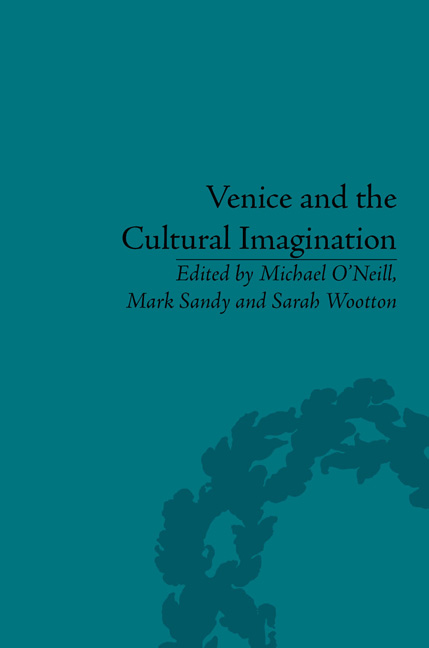Book contents
- Frontmatter
- CONTENTS
- Acknowledgements
- List of Figures
- Notes on Contributors
- Introduction
- 1 A ‘More Beloved Existence’: From Shakespeare's ‘Venice’ to Byron's Venice
- 2 Reimagining Venice and Visions of Decay in Wordsworth, the Shelleys and Thomas Mann
- 3 J. M. W. Turner and the ‘Floating City’
- 4 Venice and Opera: Tradition, Propaganda and Transformation
- 5 Venice, Dickens, Robert Browning and the Victorian Imagination
- 6 ‘The Lamp of Memory’: Ruskin and Venice
- 7 Edith Wharton's ‘Venetian Backgrounds’
- 8 Henry James's Venice and the Visual Arts
- 9 The Myth of Venice in the Decline of Eliot and Pound
- 10 Representations of Venice in Daphne du Maurier's Don't Look Now and Nicolas Roeg's Screen Adaptation
- Notes
- Select Bibliography
- Index
5 - Venice, Dickens, Robert Browning and the Victorian Imagination
- Frontmatter
- CONTENTS
- Acknowledgements
- List of Figures
- Notes on Contributors
- Introduction
- 1 A ‘More Beloved Existence’: From Shakespeare's ‘Venice’ to Byron's Venice
- 2 Reimagining Venice and Visions of Decay in Wordsworth, the Shelleys and Thomas Mann
- 3 J. M. W. Turner and the ‘Floating City’
- 4 Venice and Opera: Tradition, Propaganda and Transformation
- 5 Venice, Dickens, Robert Browning and the Victorian Imagination
- 6 ‘The Lamp of Memory’: Ruskin and Venice
- 7 Edith Wharton's ‘Venetian Backgrounds’
- 8 Henry James's Venice and the Visual Arts
- 9 The Myth of Venice in the Decline of Eliot and Pound
- 10 Representations of Venice in Daphne du Maurier's Don't Look Now and Nicolas Roeg's Screen Adaptation
- Notes
- Select Bibliography
- Index
Summary
Put on very dark sunglasses: protect yourself. Venice can be lethal. In the historic centre the aesthetic radioactivity is extremely high. Every angle radiates beauty; apparently shabby: profoundly devious, inexorable. The sublime pours in bucket-loads from the churches … You are face-butted, slapped, abused by beauty.
Tiziano Scarpa's amusing riff from his Venezia E'Un pesce (Venice Is a Fish), a work which also tells us that Venice ‘is constipated by the past’, reminds us that Venice is both miracle and byword; pace T. S. Eliot, it is the unrealest of cities; long before Calvino, it is the supreme idea of the invisible city made visible, but made visible in such a way that materiality seems instantly to resolve back into the mental, the immaterial, the idea.
1
Calvino's Marco Polo tells Kubla Khan: ‘I have also thought of a model city from which I deduce all the others … It is a city made only of exceptions, exclusions, incongruities, contradictions’. This is Venice as the city from which all cities are deducible because it is their contradictory other and uncanny neighbour. As such it shadows the Victorian cultural imagination: magnificent opposite of the fog-ridden capital city and yet also double, since, as an empire founded on trade, Venice serves as type and warning, ‘in the fall | Of Venice’, Byron had warned his fellow-citizens, ‘think of thine, despite thy watery wall’.
- Type
- Chapter
- Information
- Venice and the Cultural Imagination'This Strange Dream upon the Water', pp. 79 - 94Publisher: Pickering & ChattoFirst published in: 2014



